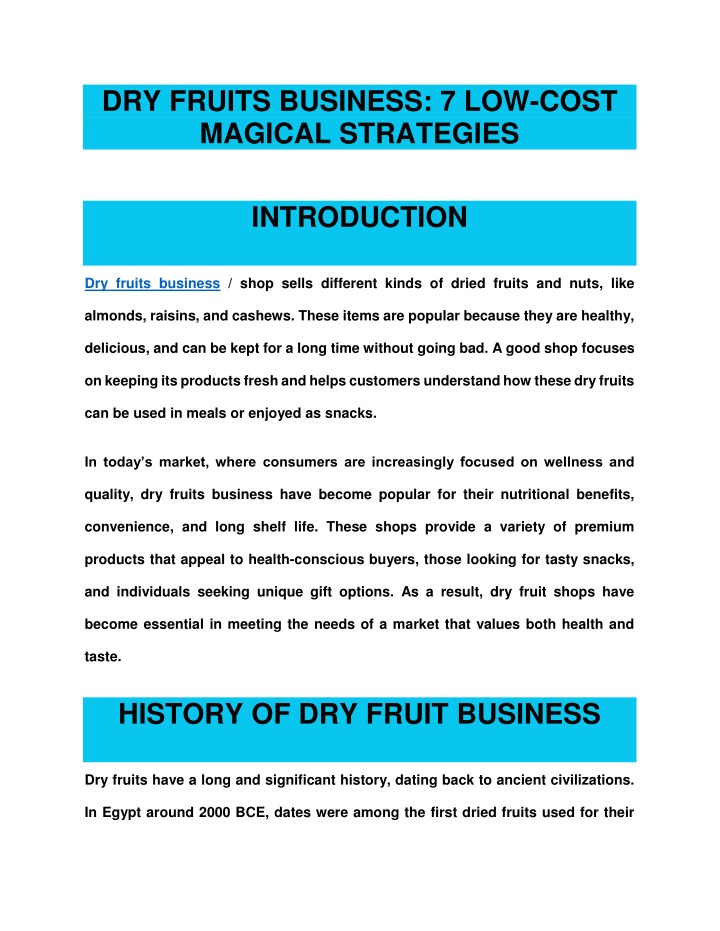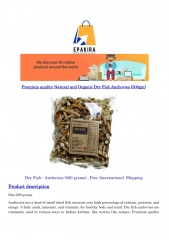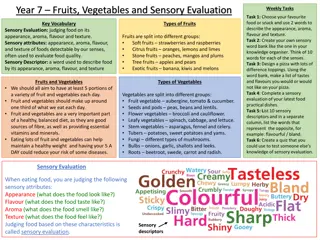
DRY FRUITS BUSINESS: 7 LOW-COST MAGICAL STRATEGIES
//seribangash.com/nDry fruits business / shop sells different kinds of dried fruits and nuts, like almonds, raisins, and cashews. These items are popular because they are healthy, delicious, and can be kept for a long time without going bad. A g
Download Presentation

Please find below an Image/Link to download the presentation.
The content on the website is provided AS IS for your information and personal use only. It may not be sold, licensed, or shared on other websites without obtaining consent from the author. If you encounter any issues during the download, it is possible that the publisher has removed the file from their server.
You are allowed to download the files provided on this website for personal or commercial use, subject to the condition that they are used lawfully. All files are the property of their respective owners.
The content on the website is provided AS IS for your information and personal use only. It may not be sold, licensed, or shared on other websites without obtaining consent from the author.
E N D
Presentation Transcript
DRY FRUITS BUSINESS: 7 LOW-COST MAGICAL STRATEGIES INTRODUCTION Dry fruits business / shop sells different kinds of dried fruits and nuts, like almonds, raisins, and cashews. These items are popular because they are healthy, delicious, and can be kept for a long time without going bad. A good shop focuses on keeping its products fresh and helps customers understand how these dry fruits can be used in meals or enjoyed as snacks. In today s market, where consumers are increasingly focused on wellness and quality, dry fruits business have become popular for their nutritional benefits, convenience, and long shelf life. These shops provide a variety of premium products that appeal to health-conscious buyers, those looking for tasty snacks, and individuals seeking unique gift options. As a result, dry fruit shops have become essential in meeting the needs of a market that values both health and taste. HISTORY OF DRY FRUIT BUSINESS Dry fruits have a long and significant history, dating back to ancient civilizations. In Egypt around 2000 BCE, dates were among the first dried fruits used for their
sweetness and preservation qualities. The practice spread to Persia, where figs and raisins were dried for their nutritional value. Ancient Greeks and Romans also valued dried fruits like almonds and apricots, integrating them into their diets and spreading the practice throughout their empire. In Eastern cultures, such as in India and China, dried fruits were used in traditional medicine and religious ceremonies, symbolizing health and prosperity. As trade routes like the Silk Road expanded, dried fruits became an important commodity, connecting various cultures and influencing global food practices. CULTURAL OR TRADITIONAL IMPORTANCE OF DRY FRUITS Encouraging feedback and managing online reviews can help build a good reputation. Asking customers for their opinions and listening to their suggestions shows that their input is valued. Positive reviews attract new customers, while addressing any negative feedback quickly helps resolve issues and shows a commitment to great service. Dry fruits hold significant cultural and traditional importance in various cultures around the world. In India, they are integral to festivals and religious ceremonies, such as Diwali and weddings, where they are used in sweets and as offerings. In Middle Eastern cultures, dried fruits like dates and figs are often enjoyed during Ramadan and other religious celebrations, symbolizing abundance and hospitality.
In Chinese culture, dried fruits are featured in traditional dishes and are believed to bring good luck and prosperity, especially during the Lunar New Year. Similarly, in Mediterranean regions, dried fruits such as raisins and apricots are common in traditional recipes and are often associated with festive meals and celebrations. These practices highlight the role of dry fruits not just as food, but as important symbols in cultural and religious contexts. TYPES OF DRY FRUITS & BENEFITS 1 1. ALMONDS Characteristics: Hard shell, oval shape; available raw, roasted, or blanched. Nutritional Benefits: High in healthy fats, protein, vitamin E, and magnesium. Supports heart health and aids in weight management. Uses: Eaten as a snack, used in baking, cooking, or added to salads and granola. 2. WALNUTS Characteristics: Round or oval shape with a hard shell; often sold shelled.
Nutritional Benefits: Rich in omega-3 fatty acids, antioxidants, and anti- inflammatory properties. Good for brain health. Uses: Used in baking (like brownies), salads, or as a topping for yogurt and oatmeal. 3. CASHEWS Characteristics: Kidney-shaped, creamy white color; often roasted and salted. Nutritional Benefits: High in monounsaturated fats, copper, magnesium, and zinc. Supports bone health and metabolism. Uses: Snacking, used in trail mixes, or blended into creamy sauces for vegan dishes. 4. PISTACHIOS Characteristics: Small, oval, typically green in color; sold in shells or shelled. Nutritional Benefits: Good source of protein, fiber, and antioxidants. Supports heart health and weight management. Uses: Eaten as a snack, used in desserts (like baklava), or as a topping for salads.
5. HAZELNUTS Characteristics: Round, hard shell; often sold roasted and ground. Nutritional Benefits: High in healthy fats, vitamin E, and antioxidants. Beneficial for heart health and skin. Uses: Used in baking (e.g., cookies), chocolate spreads (like Nutella), or as a snack. 6. DRIED APRICOTS Characteristics: Soft, chewy texture; bright orange color. Nutritional Benefits: Rich in vitamins A and C, potassium, and fiber. Supports eye health and digestion. Uses: Eaten as a snack, added to granola, salads, or baked goods. 7. DRIED FIGS Characteristics: Sweet, chewy texture; typically brown or purple. Nutritional Benefits: High in fiber, calcium, and antioxidants. Supports digestive health and bone health. Uses: Eaten alone, added to cheese boards, or used in baking and cooking.
8. RAISINS Characteristics: Dried grapes, available in various colors (green, black, golden). Nutritional Benefits: Good source of iron, potassium, and antioxidants. Supports heart health and digestion. Uses: Used in baking (e.g., bread, cookies), salads, or as a snack. 9. DATES Characteristics: Sweet, chewy texture; often sold pitted or un pitted. Nutritional Benefits: High in natural sugars, fiber, and various vitamins and minerals. Provides energy and aids digestion. Uses: Eaten as a snack, used in energy bars, or blended into smoothies and desserts. 10. DRIED CRANBERRIES Characteristics: Tart and sweet flavor; typically sweetened and dark red. Nutritional Benefits: High in antioxidants and vitamin C. Supports urinary tract health. Uses: Added to salads, trail mixes, or baked goods.
11. SUN-DRIED TOMATOES Characteristics: Chewy, intensely flavored; typically sold packed in oil or dry. Nutritional Benefits: Rich in vitamins C and K, antioxidants, and lycopene. Supports skin health and boosts immunity. Uses: Added to pasta, salads, sandwiches, or as a pizza topping. 12. DREID COCONUT Characteristics: Shredded or flaked; can be sweetened or unsweetened. Nutritional Benefits: High in healthy fats and fiber. Supports heart health and provides energy. Uses: Used in baking, cooking, or as a topping for desserts.
HOW TO START DRY FRUITS BUSINESS 1. MARKET RESEARCH The dry fruit business / industry is growing as people increasingly choose healthy and natural snacks. This rise is because more people are learning about the benefits of dry fruits, which are nutritious and free from extra additives. Suppliers are also focusing on being more eco-friendly and transparent about their products. Additionally, there are more options available now, including exotic fruits and new items like flavored nuts and fruit mixes. Online shopping has made it easier for people to find and buy a variety of dry fruits, making the industry more lively and adaptable to what people want. 2. TARGET AUDIENCE 1. Health-Conscious Shoppers: Those who focus on eating nutritious foods and prefer natural snacks over processed ones. 2. Fitness Fans: People who are active in sports and exercise often choose dry fruits for their energy and protein benefits. 3. Gift Buyers: Customers looking for unique and thoughtful gifts, especially around holidays and special occasions, often go for dry fruit gift baskets.
4. Busy Professionals: Individuals with busy lives who need convenient, healthy snacks that are easy to carry and eat on the go. 5. Parents: Families looking for healthier snack options for their kids, as dry fruits can be a good alternative to sugary treats. 6. Cooking Enthusiasts: People who enjoy cooking and baking may look for special dry fruits to use in recipes and gourmet dishes. 3. COMPETITIVE LANDSCAPE In Pakistan, the dry fruit business / market is made up of big brands, local suppliers, and small shops. Well-known brands like Shaheen Foods and Al-Hilal are popular for their wide range of dry fruits and often offer lower prices through sales and bulk deals. Local markets and smaller stores provide unique or regional varieties of dry fruits and may focus on quality. Prices vary, with big brands usually offering lower prices and smaller shops charging more for special or high-quality products. The market is competitive, with more people looking for organic and premium options as they become more health- conscious. Online stores and delivery services are also becoming popular, giving people more choices and convenience.
4. BUSINESS PLAN Create a detailed Dry fruits business plan outlining the shop s goals, target market, pricing strategy, and financial projections. This plan will serve as a roadmap for the shop s success and can help secure funding if needed. 5. LEGAL REQUIREMENTS Register the Dry fruits business, obtain necessary licenses, and ensure compliance with local health and safety regulations. This includes understanding tax obligations and any specific rules related to food businesses. 6. LOCATION When selecting a location for dry fruit business / shop, aim for a spot with high foot traffic, such as a busy market or shopping street, to attract more potential customers. Ensure the shop is easily accessible, with good public transport options or ample parking, as convenience can significantly impact customer visits. Additionally, choose a location that aligns with target audience; for instance, a health-conscious area could be ideal for promoting premium dry fruits.
7. STORE LAYOUT To make dry fruit business / shop inviting and user-friendly, arrange the layout so customers can easily find what they re looking for by grouping similar items together and using clear signage. Create attractive displays with shelves and containers to highlight the variety and quality of products. Additionally, consider setting up a sampling station where customers can taste different dry fruits; this can help them choose what they like and encourage more purchases. 8. DESIGN AND ATMOSPHERE Create a welcoming environment in dry fruit shop with pleasant colors, good lighting, and comfortable fixtures. Keep the space clean and organized, making sure that packaging and containers always look fresh. Incorporate shop s colors and logo into the design to build a consistent and memorable brand identity. 9. SUPPLIER RELATIONSHIPS Establish relationships with reliable suppliers to source high-quality dry fruits at competitive prices. Consider working with local farmers, wholesalers, or importers to ensure a steady supply of products.
10. INVENTORY MANAGEMENT Implement an efficient inventory management system to track stock levels, avoid spoilage, and ensure products are fresh. Use a first-in, first-out (FIFO) system to manage stock effectively. 11. BRANDING Branding is essential for making a dry fruit business / shop stand out. A strong brand helps create a memorable impression and sets the shop apart from competitors. Having a unique logo, consistent colors, and clear messaging builds trust with customers and ensures the shop is easily recognizable. Effective branding attracts customers and encourages loyalty by demonstrating reliability and quality. It also highlights what makes the shop special, helping customers choose its products over others. 12. PRICING STRATEGY Set competitive prices based on market research, cost of goods, and desired profit margins. Offer a range of products at different price points to cater to various customer segments.
13. DIGITAL MARKETING Digital marketing is a great way to promote a dry fruit shop. Using social media helps connect with potential customers through posts, special offers, and ads. Setting up an online store can also reach more people by offering easy shopping and delivery. Plus, good SEO practices can make the shop easier to find when people search for dry fruits online. 14. OFFLINE MARKETING Offline marketing is also important for building a local presence. Handing out flyers, joining local events, and teaming up with other businesses can help attract customers in the area. Flyers can advertise special deals, while local events and collaborations offer chances to interact with people directly and boost the shop s visibility. Combining these traditional methods with online efforts creates a strong marketing strategy to draw in and keep customers. 15. CUSTOMER SERVICE Providing great customer service is key to making sure people have a positive experience at a dry fruit shop. Personalized service, like remembering regular customers preferences and giving tailored recommendations, helps make customers feel valued. Friendly and attentive interactions not only keep customers happy but also encourage them to return and spread the word about the shop.
16. LOYALTY PROGRAMS Loyalty programs are a smart way to keep customers coming back and encourage repeat purchases. Offering rewards, discounts, or points for every purchase gives customers a reason to choose the shop again. These programs make customers feel appreciated and more likely to stick with the shop rather than trying others. 17. SEASONAL AND FESTIVE OFFERINGS Create special packages or promotions during festivals and holidays when dry fruits are in high demand. This can help boost sales and attract more customers during peak seasons. 18. EDUCATE CUSTOMERS Provide information on the health benefits of different dry fruits, how to store them, and ways to use them in cooking. Educating customers can enhance their shopping experience and encourage more purchases. 19. FOCUS ON QUALITY CONTROL Regularly check the quality of products to ensure they meet high standards. Offering consistently fresh and high-quality dry fruits will keep customers satisfied and coming back.
20. FEEDBACK AND REVIEWS Encouraging feedback and managing online reviews can help build a good reputation. Asking customers for their opinions and listening to their suggestions shows that their input is valued. Positive reviews attract new customers, while addressing any negative feedback quickly helps resolve issues and shows a commitment to great service. 21. SEASONAL DEMAND Managing the ups and downs of seasonal sales can be tricky for a dry fruit shop. Demand often increases during festivals or winter but may slow down at other times. Planning ahead by looking at past sales can help stock the right amount of products during busy seasons without overstocking during quieter times. Running seasonal promotions can also keep sales steady throughout the year. 22. INVENTORY MANAGEMENT Proper inventory management is key to preventing spoilage and waste, especially since dry fruits can go bad if not sold in time. Regularly checking stock levels, using older products first, and keeping an eye on expiration dates can help ensure that everything stays fresh. Predicting demand accurately and maintaining a balanced inventory can prevent both overstocking and shortages.
23. REGULATORY COMPLIANCE Following local health and safety rules is important for any dry fruit shop. This includes storing products properly, keeping the shop clean, and making sure labels meet legal standards. Staying informed about local regulations and regularly checking that everything is in order helps avoid problems and ensures the shop is safe and trustworthy for customers. 24. FINANCIAL MANAGEMENT Keep track of finances by maintaining accurate records of sales, expenses, and profits. Regularly review financial performance to make informed decisions and ensure the business stays profitable. 25. CONTINUOUS IMPROVEMENT Regularly gather customer feedback and analyze sales data to identify areas for improvement. Stay updated on market trends and be willing to adapt strategies to keep the shop successful over time.
26. EMPLOYEE TRAINING AND DEVELOPMENT Encouraging feedback and managing online reviews can help build a good reputation. Asking customers for their opinions and listening to their suggestions shows that their input is valued. Positive reviews attract new customers, while addressing any negative feedback quickly helps resolve issues and shows a commitment to great service. ADVANTAGES OF A DRY FRIUITS BUSINESS 1. High Demand: Dry fruits are popular for their health benefits, making them a product with consistent demand throughout the year. 2. Long Shelf Life: Unlike fresh produce, dry fruits have a longer shelf life, reducing the risk of spoilage and allowing for more flexible inventory management. 3. Seasonal Sales Boosts: Festivals and holidays often see a surge in dry fruit sales, providing opportunities for increased revenue during these times. 4. Health-Conscious Market: With growing awareness of healthy eating, dry fruits appeal to health-conscious consumers, offering a steady and expanding market. 5. Diverse Product Range: A wide variety of dry fruits allows for product diversification, catering to different tastes and budgets, which can attract a broader customer base.
DISADVANTAGES OF A DRY FRUITS BUSINESS 1. Sales Can Fluctuate: While festivals bring more customers, there may be slower periods in between, so you ll need to plan carefully. 2. Tough Competition: There might be many other shops selling dry fruits, both in-store and online, making it harder to stand out. 3. High Start-Up Costs: Opening a dry fruit shop can be expensive, with costs for inventory, setting up the store, and marketing. 4. Price Sensitivity: Customers might be sensitive to price changes, especially if the cost of dry fruits goes up, which could affect profits. 5. Maintaining Quality: It s important but sometimes challenging to keep the dry fruits fresh and of good quality over time. 6. Meeting Regulations: You ll need to follow food safety rules, which can be time-consuming and costly, and any mistakes could lead to fines or disruptions. CULINARY USES OF DRY FRUITS BUSINESS Dry fruits are highly versatile ingredients in cooking and baking, adding flavor, texture, and nutritional value to a wide variety of dishes. Rich in vitamins, minerals, and healthy fats, they are used in both savory and sweet recipes across different cuisines. Below are some popular culinary uses of dry fruits.
1. Snacks and Trail Mixes On-the-Go Snacks: Dry fruits like almonds, cashews, raisins, and dates are commonly eaten as healthy snacks. They are convenient, portable, and packed with energy. Trail Mix: A combination of nuts, seeds, and dried fruits, such as raisins, dried cranberries, and apricots, is a popular snack for hikers and athletes due to its high energy content. 2. Baking and Desserts Cakes and Cookies: Dry fruits are often added to cakes, cookies, and pastries. Raisins, dates, walnuts, and dried apricots are common ingredients in fruit cakes, oatmeal cookies, and muffins. Energy Bars and Bites: Dates, figs, and almonds are key ingredients in homemade energy bars and bites, providing natural sweetness and a chewy texture. Puddings and Sweets: Dry fruits are a staple in many traditional desserts, such as rice puddings, fruit compotes, and Middle Eastern sweets like baklava, where nuts like pistachios and walnuts add crunch and flavor.
3. Breakfast Dishes Cereals and Granola: Dry fruits like raisins, dried cranberries, and dates are often added to cereals, granola, and oatmeal for added sweetness and texture. Smoothies: Soaked dates, dried figs, and almonds are commonly used in smoothies to enhance the nutritional profile and add natural sweetness. Yogurt Toppings: Dry fruits such as chopped almonds, cashews, and dried apricots make excellent toppings for yogurt bowls, adding crunch and flavor. 4. Savory Dishes Rice and Pilaf: In many cuisines, dry fruits like raisins, almonds, and cashews are used in rice dishes and pilafs, such as Indian biryani and Middle Eastern pilaf, to add sweetness and texture. Stuffing s: Nuts and dried fruits like cranberries, raisins, and apricots are often used in savory stuffing s for meats like chicken, turkey, or lamb, imparting a sweet-savory balance. Salads: Almonds, walnuts, and dried cranberries or figs can be tossed into salads for added crunch and a hint of sweetness.
5. Sauces and Chutneys Fruit-Based Sauces: Dried fruits like apricots and prunes are sometimes simmered down into rich sauces for meats or roasted vegetables, providing a sweet contrast to savory flavors. Chutneys: Dry fruits such as raisins and dates are common ingredients in chutneys and relishes, adding sweetness and depth to tangy or spicy dishes, particularly in Indian cuisine. 6. Confectionery and Chocolates Chocolate Coating: Dry fruits such as almonds, hazelnuts, and raisins are often coated in chocolate to make confections, a popular treat for snacking or gifting. Candies and Brittle: Nuts like peanuts, almonds, and cashews are used in making candies and nut brittles, adding crunch and richness to the sweets. 7. Drinks and Infusions oMilkshakes and Lassis: Dry fruits like dates, almonds, and pistachios are blended into milkshakes and traditional drinks like lassis for added richness and flavor.
oInfusions: Some dry fruits, especially dried berries and figs, are used to infuse teas or flavor syrups, giving drinks a subtle sweetness and complexity. TOP 10 COUNTRIES KNOWN FOR THEIR DRY FRUITS BUSINESS 1 1. United States Major producer of almonds, walnuts, and pistachios, particularly in California. 2. Iran Renowned for its high-quality pistachios, figs, and dates. 3. Turkey Leading producer of hazelnuts and dried fruits like apricots and figs. 4. India Significant market for cashews, almonds, and a variety of dried fruits, including raisins and dates. 5. China Major producer of dried goji berries, dates, and various nuts. 6. Spain Known for its dried fruits, especially raisins and figs. 7. Saudi Arabia
Notable for date production, with a vast market for various dried fruits. 8. Mexico Increasingly recognized for its production of dried mangoes and nuts. 9. Greece Produces high-quality dried figs and almonds, with a strong export market. 10. Afghanistan Known for its unique varieties of dried fruits, especially raisins and nuts. DRY FRUIT PRICES IN 2024 IN SOME COUNTRIES United States: oAlmonds: $6 to $10 per pound oWalnuts: $5 to $8 per pound oRaisins: $2 to $4 per pound India: oCashews: 700 to 1,200 per kg oAlmonds: 800 to 1,500 per kg oPistachios: 1,200 to 2,000 per kg United Arab Emirates:
oDates: AED 20 to AED 50 per kg oPistachios: AED 70 to AED 120 per kg oDried Apricots: AED 30 to AED 80 per kg European Union (Germany, France, etc.): oAlmonds: 6 to 12 per kg oDried Figs: 5 to 10 per kg oRaisins: 4 to 8 per kg China: oWalnuts: 50 to 100 per kg oDried Apricots: 60 to 120 per kg oDates: 40 to 80 per kg STORAGE AND HANDLING OF DRY FRUITS Proper storage and handling of dry fruits are essential to maintain their freshness, flavor, and nutritional value. Dry fruits, such as almonds, cashews, raisins, walnuts, and dates, are sensitive to moisture, heat, and exposure to air, which can degrade their quality over time. Below are some guidelines for effectively storing and handling dry fruits.
Storage Tips Use Airtight Containers: Store dry fruits in airtight containers to protect them from moisture and exposure to air. Glass jars or plastic containers with tight-fitting lids are ideal for this purpose. Cool, Dark, and Dry Environment: Dry fruits should be stored in a cool, dark, and dry place, such as a pantry or cupboard. Direct sunlight, heat, and humidity can cause the fruits to spoil more quickly. Refrigeration for Long-Term Storage: For long-term storage, particularly in warm climates, keeping dry fruits in the refrigerator is recommended. This slows down the oxidation process and helps retain freshness. Freezing for Extended Freshness: Dry fruits can be frozen in sealed bags or containers. This is particularly useful if you plan to store them for several months. Ensure they are thawed slowly to maintain texture and taste. Use Vacuum Sealing: Vacuum-sealing dry fruits reduces exposure to air and moisture, significantly extending their shelf life.
2. Handling Tips Avoid Moisture Exposure: When handling dry fruits, ensure your hands and any utensils used are dry. Moisture can cause mold growth and spoilage. Rotate Stock Regularly: To avoid spoilage, practice the first in, first out method, where older stock is used before newer purchases. Do Not Mix Different Types: It is advisable not to store different types of dry fruits together, as some may release oils or moisture that can affect the quality of others. Check for Signs of Spoilage: Before using dry fruits, check for signs of spoilage, such as an off smell, mold, or changes in texture. 3. Shelf Life of Common Dry Fruits Almonds: Shelf life of up to 1 year when stored in a cool, dry place, or up to 2 years in the freezer. Cashews: Can last up to 6 months in a pantry or 1 year when refrigerated. Raisins: Best consumed within 6 months when stored at room temperature; can last up to 1 year if refrigerated. Walnuts: Typically last 6 months in a pantry and up to 1 year in the refrigerator or freezer.
Dates: Can be stored for up to 1 year at room temperature, or longer if refrigerated. 4. Health and Safety Considerations Allergen Awareness: Be aware that dry fruits like nuts can be allergens. Handle them carefully if someone in your household has nut allergies. Organic vs. Conventional: Organic dry fruits may have a shorter shelf life due to the absence of preservatives. Keep this in mind when purchasing and storing them. For more blogs please visit : https://seribangash.com/dry-fruits- business-strategies-for-success-2024/ https://seribangash.com/computer-accessories-shop-8-innovative-ideas/ https://seribangash.com/silk-road-magical-treasures-trade-and-business/






















